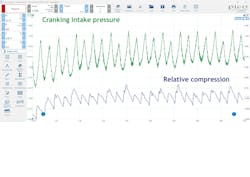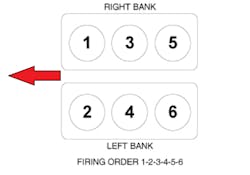Welcome back to another edition of “The Data Doesn’t Lie,” a regular feature in which I pose a puzzling case study, followed by the answers to the previous issue’s puzzle.
I received a call from a friend of mine (Rick) out of Chicagoland. It seems he was faced with a 2019 Dodge Durango with a 3.6L engine, and the complaint of DTC P0300 and misfires being flagged for cylinder No. 1. According to Rick, the PCM only registered misfires above 3,000 rpm.
Rick evaluated both the ignition and fuel injection system (with no issues found) prior to reaching out to me. Rick captured and shared engine-mechanical waveforms for the entire engine, overall from his digital storage oscilloscope. The waveforms reflect cranking-intake pressure and relative compression (Figure 1). This capture was sent with the question on what I see wrong with cylinder No. 1.
Initial Analysis
As we’ve discussed in previous articles, it's important to understand the limitation of the test you are performing. The relative compression test is capable of showing a cylinder(s) deficient in compression as this typically affects starter load. And, although the test results will infer a loss of compression (when that fault is present) the result truly reflects a variation in starter load. However, if there is no significant variation in compression between cylinders, the results of the test may not display the fault.
With that, the BLUE relative compression test indicates variation in starter load, but for multiple cylinders (almost in an erratic nature). The GREEN trace shows a rhythmic variation in contribution to the intake manifold.
A bit of research regarding the configuration of this engine offers a clue that is worth pursuing, in my opinion. When researching the firing order of this particular engine, we also learn the cylinder configuration, and where bank No. 1 is (Figure 2). After analyzing both the above figures. I was able to offer some advice to Rick on what to pursue next.
The Data Doesn’t Lie
With all the information in front of us, and the desired information not yet obtained, we are faced with deciding how to proceed. Here are some bullet points of what we know to be factual, and I will ask all of you, diligent readers, for your input on what they mean to you, collectively:
- MIL illuminated and P0300 stored in PCM history
- Misfires only occur at approximately 3,000 rpm
- Cylinder No. 1 is the only cylinder that continues to flag misfires
- Engine-mechanical waveforms and engine configuration data combine to offer a clue
Given this information, what would you do next?
- Condemn intake valve integrity for cylinder No. 1
- Condemn exhaust valve integrity for cylinder No. 1
- Condemn engine for multiple cylinders’ valve integrity
- Inspect for a bank-to-bank breathability issue
Take our quiz! Can you diagnose this vehicle?
About the Author
Brandon Steckler
Technical Editor | Motor Age
Brandon began his career in Northampton County Community College in Bethlehem, Pennsylvania, where he was a student of GM’s Automotive Service Educational program. In 2001, he graduated top of his class and earned the GM Leadership award for his efforts. He later began working as a technician at a Saturn dealership in Reading, Pennsylvania, where he quickly attained Master Technician status. He later transitioned to working with Hondas, where he aggressively worked to attain another Master Technician status.
Always having a passion for a full understanding of system/component functionality, he rapidly earned a reputation for deciphering strange failures at an efficient pace and became known as an information specialist among the staff and peers at the dealership. In search of new challenges, he transitioned away from the dealership and to the independent world, where he specialized in diagnostics and driveability.
Today, he is an instructor with both Carquest Technical Institute and Worldpac Training Institute. Along with beta testing for Automotive Test Solutions, he develops curriculum/submits case studies for educational purposes. Through Steckler Automotive Technical Services, LLC., Brandon also provides telephone and live technical support, as well as private training, for technicians all across the world.
Brandon holds ASE certifications A1-A9 as well as C1 (Service Consultant). He is certified as an Advanced Level Specialist in L1 (Advanced Engine Performance), L2 (Advanced Diesel Engine Performance), L3 (Hybrid/EV Specialist), L4 (ADAS) and xEV-Level 2 (Technician electrical safety).
He contributes weekly to Facebook automotive chat groups, has authored several books and classes, and truly enjoys traveling across the globe to help other technicians attain a level of understanding that will serve them well throughout their careers.


